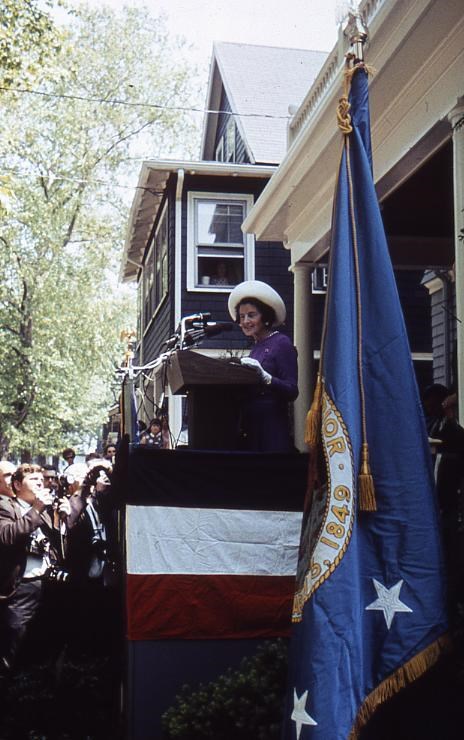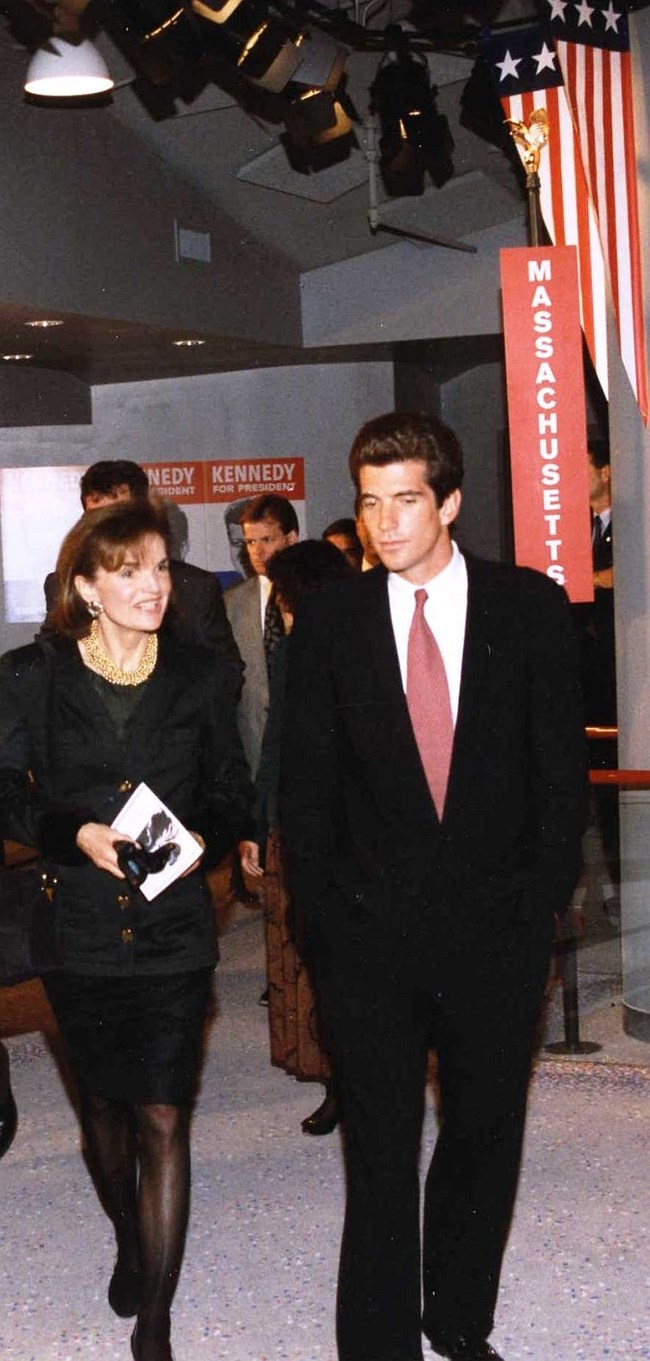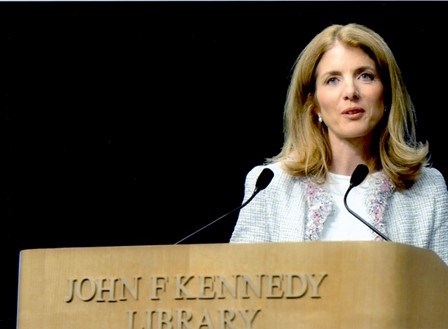Last updated: February 10, 2021
Article
Commemorating Camelot: Three Women Who Shaped JFK’s Legacy
“There’ll be great presidents again ... but there’ll never be another Camelot again.”
– Jacqueline Kennedy
In the years following President Kennedy’s assassination, three Kennedy women worked to commemorate his life and legacy. Rose, his mother, relied upon her memories to recreate his birthplace as the John Fitzgerald Kennedy National Historic Site. Jackie, his wife, used her experiences as First Lady to inform her vision of the John F. Kennedy Presidential Library and Museum. A generation later, Caroline, his daughter, would continue their efforts by establishing the Profile in Courage Award. Each of these women had a strong understanding of image making and legacy, and shaped the national memory of President Kennedy beyond the 1960s. Together these women shaped the public’s remembrance of President Kennedy by likening him to King Arthur, a hero who embodied courage, diplomacy, and self-sacrifice. They also created the perception that the Kennedy presidency was like the era of Camelot, a mythical time associated with a sense of unfulfilled promise.

NPS/Cecil Stoughton

 A Mother's Memory
A Mother's Memory
Joseph and Rose Kennedy moved to 83 Beals Street in Brookline, Massachusetts following their wedding in 1914. Their second child, John Fitzgerald Kennedy, was born in the home on May 29, 1917. Mrs. Kennedy restored the home to its appearance on the day of his birth and donated it to the National Park Service as a memorial to him. In recent years, the site receives around 30,000 visitors annually.
Mrs. Kennedy hoped that visitors would learn that President Kennedy’s political ideals were rooted to his earliest experiences. Even before her children began formal schooling, Mrs. Kennedy used domestic spaces and activities to educate and prepare them for public service. She filled their home with objects that encouraged their interest in geography, music, and art. She also structured family mealtimes with conversations and games that helped them learn about historic figures and current events. When her children were sick, she read stories to them with characters that served as proper role models.
One of the books Mrs. Kennedy chose to read to her children with this goal in mind was King Arthur and His Knights. She recalls that it became one of John’s particular favorites. It not only provided the future President with exciting adventures to imagine while he recovered from various illnesses; it also gave him a set of moral principles to value from an early age. King Arthur exhibited great courage, valued service to others above self-interest, and exercised diplomacy and negotiation during his reign. As he grew older, John F. Kennedy would strive to emulate this mythical hero as he took on positions of political leadership. He also developed a fondness for the Lerner and Loewe musical Camelot that debuted in 1960, the same year he was elected to the nation’s highest office.
When Mrs. Kennedy returned to the President’s birthplace, she placed a copy of King Arthur in the nursery to signal its importance to her late son.

John F. Kennedy Library and Museum

 A Wife's Experiences
A Wife's Experiences
Jacqueline Kennedy became heavily involved in planning her husband’s funeral, planning nearly every aspect including the plot and eternal flame at Arlington National Cemetery.
One of Jacqueline Kennedy’s next efforts to commemorate her husband was through a series of interviews with historian and presidential advisor Arthur Schlesinger Jr. in which she described her experiences as First Lady. The LIFE Magazine article derived from these interviews emphasized the comparison she drew between the Kennedy administration and King Arthur’s Camelot because of the promising but fleeting nature of both eras. This comparison would profoundly shape early efforts to commemorate President Kennedy by establishing a particular view of his life and legacy.
Jackie urged President Lyndon B. Johnson to change the name of Cape Canaveral and the surrounding space center to honor President Kennedy. Cape Kennedy would hold that name for 10 years before opposition from local Floridians reverted the name back to Cape Canaveral. The John F. Kennedy Space Center continues to honor President Kennedy who "lighted the imagination of our people when he set the moon as our target and man as the means to reach it."1
Planning for the National Cultural Center began during the Eisenhower administration, but failed to gain traction and funding. Still in the planning stages during the Kennedy administration, Jackie and former First Lady Mamie Eisenhower served as honorary co-chairwomen, spearheading the process and putting the prestige of the administration behind it. President Johnson signed the John F. Kennedy Center Act in 1964, officially changing the name to honor the late president.
Continuing her work outside of Washington DC, Jackie oversaw the creation of the John F. Kennedy Presidential Library and Museum. She sought to capture the sense of potential that characterized her late husband’s presidency so that future generations could better understand and feel inspired by it. Over the next fifteen years, she worked hard to make this vision of the library and museum a reality. Perhaps most notably, she selected the young and relatively obscure I. M. Pei from a pool of many qualified candidates to be the site’s head architect. Despite his lack of experience, she believed that he was full of promise and capable of imagining a structure that would reflect the ideals with which she wanted her husband to be associated. The building Pei designed is best known for the open glass-paneled space that visitors enter after viewing the museum exhibits. Pei designed this space to foster personal reflection after learning about President Kennedy’s life and contributions.
Jackie also encouraged the establishment of Harvard University’s Institute of Politics with funds raised by the Kennedy Library Corporation in order to create a space that would facilitate the continued study of politics and public affairs.
1Exec. Order No. 11129, 3 C.F.R. 794 (1959-1963)

Photo by Tom Fitzsimmons/courtesy of John F. Kennedy Library Foundation.
 A Daughter's Ideals
A Daughter's Ideals
President Kennedy’s mother and wife sought to commemorate his life by associating him with a particular set of ideals. The more recent work of his daughter seeks to make his legacy accessible to the next generation by demonstrating how those ideals continue to be relevant. In 1989, Caroline Kennedy helped to establish the Profile in Courage Award. This award was inspired by President Kennedy’s 1956 book Profiles in Courage, which chronicles the lives of eight senators who demonstrated extraordinary bravery, refusing to be swayed from a moral course even under extreme pressure. Accordingly, the Profile in Courage Award acknowledges individuals who demonstrate great bravery in public service.
Caroline Kennedy has administered the Profile in Courage Award to a diverse group of recipients for over twenty years. While it is most commonly given to public officials who serve at the local, state, or national levels, the award has also been given under special circumstances to international figures and to non-government officials. In 2002, Caroline edited a companion volume to her father’s titled Profiles in Courage for Our Time. In this book, she commemorated figures who lived according to the moral principles that her father first admired as a child when he read about King Arthur and demonstrated during his presidency.
Like the tale of King Arthur, President Kennedy’s story lives on as contemporary mythology about a modern hero. The Kennedy women who commemorated him over the past fifty years were instrumental in creating and sustaining this mythology. It is in part because of the work of these women that President Kennedy’s legacy endures and continues to inspire new generations.
